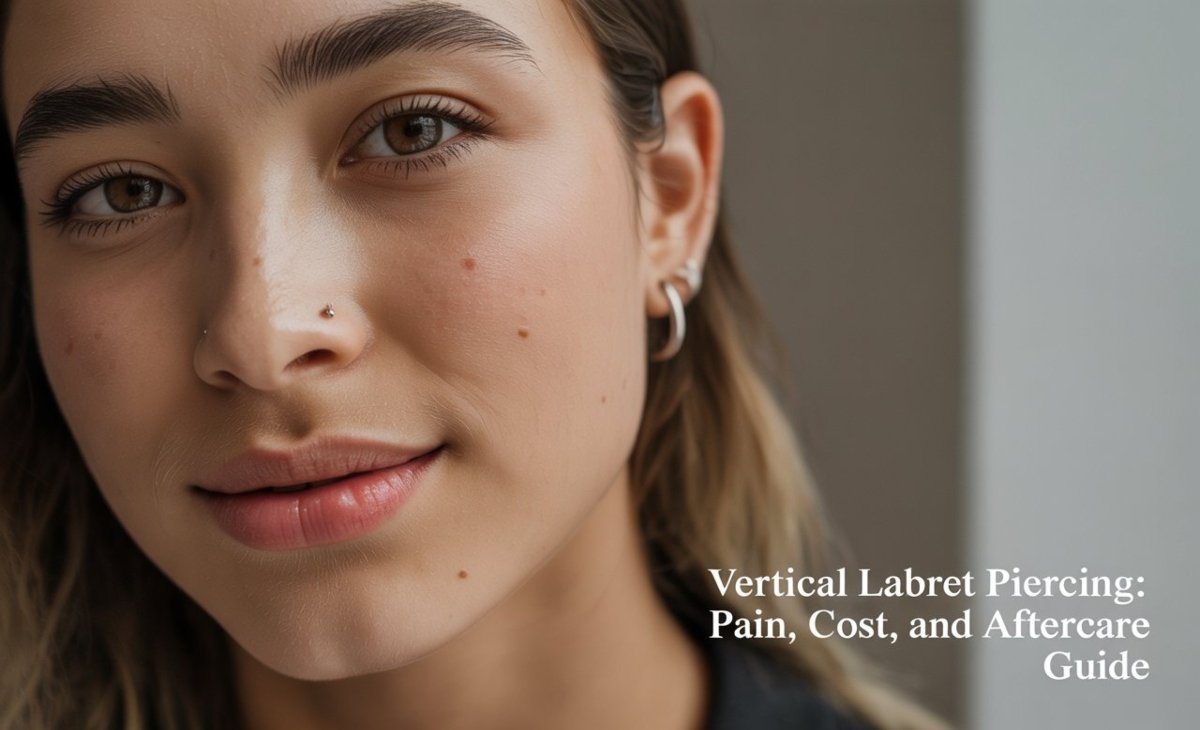Thinking about adding a bold twist to your look? A vertical labret piercing might be exactly what you’re searching for. This unique lip piercing stands out because both ends of the jewelry remain visible on the outside of your lip, giving it a striking and stylish appeal. Unlike traditional labret piercings that go inside the mouth, this one is all external, which also makes healing a little easier.
But before you grab your phone to book an appointment, there are a few things you should know. From how much it hurts, to healing time, to the types of jewelry you can wear—let’s break it all down so you can make the best decision for your next piercing.
What Is a Vertical Labret Piercing?
A vertical labret piercing is a type of lip piercing that runs vertically through the center of the bottom lip. The jewelry enters just below the lip and exits at the top of the lower lip, allowing both ends of the barbell to be visible.
This makes it different from a standard labret piercing, which goes straight through the skin beneath the lip and sits partially inside the mouth. Because the vertical labret doesn’t touch the inside of your mouth, it’s often cleaner and less prone to complications from saliva bacteria.
Most piercers use a curved barbell for this piercing, which follows the natural shape of the lip and sits comfortably.
Why Choose a Vertical Labret Piercing?
There are plenty of reasons people love this piercing:
- Unique Look: The placement is eye-catching and instantly makes a statement.
- No Inside-Mouth Contact: Since it doesn’t sit against your gums or teeth, there’s less risk of dental damage compared to other lip piercings.
- Faster Healing: Because the piercing avoids the moist environment of the mouth, it generally heals quicker.
However, this piercing isn’t for everyone. The anatomy of your lip plays a huge role in whether it’s possible. A professional piercer will check your lip shape and tissue thickness before moving forward.
How Painful Is a Vertical Labret Piercing?
Pain is subjective, but most people rate this piercing a 4 out of 10. You’ll feel a sharp pinch as the needle passes through the lip, followed by a short throbbing sensation.
The good news? The discomfort is brief, and any soreness usually fades within a couple of days. Swelling is common in the first week, but proper aftercare will help keep it under control.
Healing Time and Aftercare
Healing typically takes 6 to 8 weeks, though some people may take longer—up to 3 or 4 months—for full recovery.
To care for your new piercing:
- Clean the area with a sterile saline or sea salt solution twice daily.
- Avoid touching or twisting the jewelry unnecessarily.
- Keep skincare and makeup away from the piercing site.
- Stay away from smoking and alcohol for at least the first two weeks.
Because your lips are constantly moving, this piercing requires careful attention. Be mindful of habits like biting your lip, tugging at the jewelry, or snagging it on utensils while eating.
Cost of a Vertical Labret Piercing
The price varies depending on location and the piercer’s experience. On average, expect to pay $30 to $100.
Factors that influence cost include:
- The studio’s reputation and location.
- The type of jewelry you choose.
- Follow-up visits for jewelry downsizing as swelling goes down.
Keep in mind that the initial jewelry might need replacing during the healing phase, so factor in extra costs for high-quality barbells.
Jewelry Options for Vertical Labret Piercings
Choosing the right jewelry is just as important as choosing the piercing itself. The most common type is the curved barbell, available in several materials:
- Titanium: Hypoallergenic and lightweight, perfect for sensitive skin.
- Implant-Grade Stainless Steel: Durable and affordable, widely used in piercing studios.
- Gold (14k–18k): Stylish and safe, but make sure it’s solid, not plated, to prevent irritation.
Gauge size usually ranges from 14G to 16G, and the length depends on your lip’s thickness. Your piercer will size it appropriately and may recommend downsizing once swelling reduces.
Common Problems and Risks
Like any piercing, vertical labrets come with risks. Here are the most common issues:
- Swelling: Normal in the first few days, but prolonged swelling may signal infection.
- Migration: The jewelry might shift if the piercing isn’t suited to your anatomy.
- Infection: Signs include redness, discharge, and intense pain. Always see a piercer or doctor if you suspect this.
The key to avoiding problems is proper aftercare and choosing an experienced professional piercer.
Tips for a Smooth Piercing Experience
- Choose a professional piercer with strong reviews and hygienic practices.
- Invest in high-quality jewelry from the start—it reduces irritation.
- Follow aftercare instructions strictly, especially in the first month.
- Schedule follow-up appointments to downsize jewelry as swelling subsides.
Final Words
A vertical labret piercing is an edgy yet elegant choice for anyone looking to highlight their lips with a bold accessory. With proper care, professional guidance, and the right jewelry, it can heal smoothly and become a stylish part of your look.
If you’re considering it, book a consultation with a trusted piercer. They’ll help you determine if your anatomy is right for this piercing and guide you through the process from start to finish.
Frequently Asked Questions
Can I change my vertical labret jewelry at home?
Yes, but only after the piercing has fully healed. To switch it out, unscrew one end of the barbell and carefully thread in the new jewelry. If you’re unsure, ask your piercer to handle the first few changes.
Does everyone’s lip shape allow for this piercing?
No. Some lip anatomies simply won’t support a vertical labret piercing. A skilled piercer will let you know if it’s suitable for you.
Will it interfere with eating or drinking?
At first, you may notice some awkwardness while eating, but most people adjust quickly. Avoid biting down on utensils, and be gentle with your lip during the healing process.
Can vertical labret piercings leave scars?
Like any body modification, there’s a chance of scarring. If removed, the piercing may leave a small mark, but usually it’s subtle.





